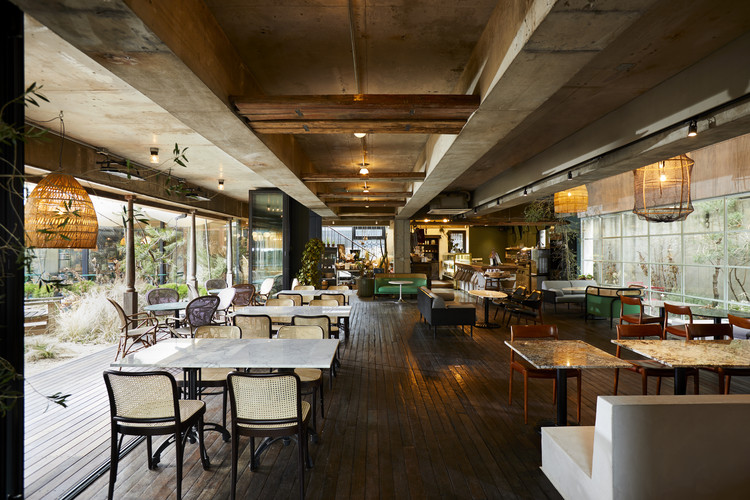Casa Julve Restoration Magén Arquitectos
2011-08-08 00:00
架构师提供的文本描述。位于阿尔卡尼兹历史名城中心,所谓的卡萨·朱尔夫的改造项目建议将这座以前的豪宅改造成一所音乐学校。
Text description provided by the architects. Located in the historical City Centre of Alcaniz, the renovation project of the so-called Casa Julve proposes the transformation of this former mansion into a School of Music.
时间的推移严重影响了大楼的维护,只允许在主要街道的海湾和主楼梯的庭院中识别结构状况差的原始设置。该项目从一开始就进行干预,直至重建模拟强调新行动和现有行动之间的明显对比,力求在保护其遗产价值和为整个项目提供内部一致性之间取得平衡。
The passage of time had significantly affected the maintenance of the building, which allowed only recognize their original settings in the bay on the main street and the courtyard of the main staircase in poor structural condition. The project involves an intervention from its beginnings as far as reconstruction mimetic emphasis on a clear contrast between the new and existing action, seeking a balance between preserving its heritage values and provide internal coherence to the entire project.
该项目通过阅读建筑物的轨迹来改变建筑物,以检索独特的物体和空间,并以新的干预措施取代建筑物后部遭受的变化,通过位于中央海湾的空隙系统建立两人之间的友好对话,同时将历史遗址连接起来,并将新的干预措施分开,允许对整体的统一感知和对视觉和空间上不同的植物的空间感。
The project transforms the building through a reading of their tracks to retrieve unique objects and spaces and replace the changes that had suffered the back of the building by a new intervention, establishing a friendly dialogue between the two through a system of voids located in the central bay while linking historical sites and separate the new intervention, allowing a unified perception of the whole and a feeling of spaciousness to the visually and spatially different plants.
新的核心垂直通信也位于中央波段,沿着分隔墙,释放了空间的剩余次要用途。在主门面之后的第一个海湾,这些用途被用来保持古代大厅的清洁空间。新的中空空间容纳了教师和行政空间。
The new core vertical communication is also located in the central band, along the dividing wall, freeing the remaining secondary uses of space. In the first bay after the main façade, the uses are placed to keep clean spaces of the ancient halls. The new hollow space houses faculty and administrative spaces.
项目发展的条件是,决定完全保持原有的比例,并向街道后院开放,作为进入和扩建建筑物的新公共空间,并占领老城镇。
Program development was conditioned by the decision to fully maintain its original proportions and open to the street back yard as a new public space of access and expansion of the building and overrun the old town.
该建筑方案的插入,代表其表面的增加,保持原来的体积,是由一个紧凑的建筑结构,组织空间和改善照明的缺口。在这一段中,还可以看到另外两个操作:第一,完全占用邻近大楼地下室和底层的地块来容纳音乐厅,另一方面,改变空心空间中较高的植物范围,以便在中间层再增加一层。
The insertion of the building program, representing an increase of its surface, keeping the original volumes, is performed by a compact architecture, structured by the gaps that organize space and improve lighting. In this section can be seen also two additional operations: first, the complete occupation of the plot in the basement and ground floor of the neighboring building to house the concert hall, on the other hand, the change in the range of plants higher in the hollow space to enable an additional floor at an intermediate level.
恢复了主要外观,尊重其原有的语言,恢复了原来的比例,恢复了Canete上的拱门和木制屋檐的画廊,并恢复了底层的石材,加强了它的基础地位。内部,突出了现有建筑的核心作用,在内部墙壁和重建他们原来的拱顶新的局部石材包层。新的内部空隙的垂直表面,照亮了clasrrom和新楼梯的家,覆盖了Iroko木板,也使用在外部木制品上。
The rehabilitation of the main facade respecting its original language, has restored its original proportions, recovering the upper gallery of arches and wooden eaves on Canete and restoring the stonework on the ground floor, reinforcing its status basamental. Inside, highlights the core role of the existing building with a new local stone cladding in interior walls and rebuilding their original vault. Vertical surfaces of the new interior voids, which illuminate the clasrrom and home to the new stairs are covered with Iroko wood panels, also used on the exterior woodwork.
 举报
举报
别默默的看了,快登录帮我评论一下吧!:)
注册
登录
更多评论
相关文章
-

描边风设计中,最容易犯的8种问题分析
2018年走过了四分之一,LOGO设计趋势也清晰了LOGO设计
-

描边风设计中,最容易犯的8种问题分析
2018年走过了四分之一,LOGO设计趋势也清晰了LOGO设计
-

描边风设计中,最容易犯的8种问题分析
2018年走过了四分之一,LOGO设计趋势也清晰了LOGO设计
































































